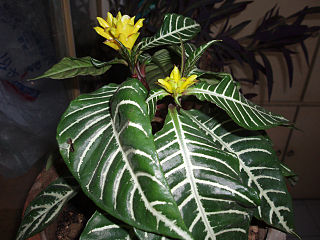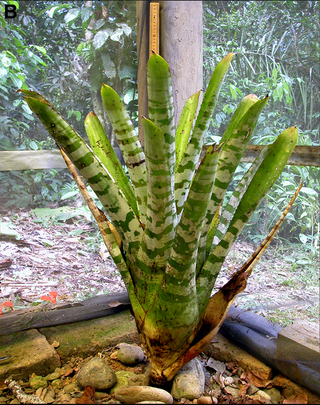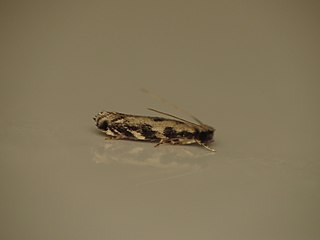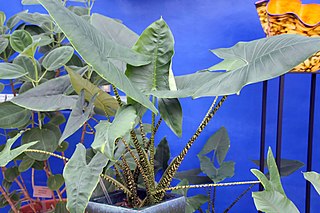
Tradescantia is a genus of 85 species of herbaceous perennial wildflowers in the family Commelinaceae, native to the Americas from southern Canada to northern Argentina, including the West Indies. Members of the genus are known by many common names, including inchplant, wandering jew, spiderwort, dayflower and trad.

The blood banana, is a variety of the wild banana Musa acuminata native to Sumatra, Indonesia. The blood banana is an ornamental plant, named for the dark red patches on its leaves, though its small-seeded fruits are also edible. It grows 6' to 8' tall in the wild, but is well-adapted to container growing and can be maintained at 3' to 5'. It grows best in full or partial sun and is hardy in zones 9 - 11.

Zebrina is a genus of air-breathing land snails, terrestrial pulmonate gastropod mollusks in the family Enidae.

Tradescantia zebrina, formerly known as Zebrina pendula, is a species of creeping plant in the Tradescantia genus. Common names include silver inch plant and wandering Jew. The latter name is controversial, and some now use the alternative wandering dude. The plant is popular in cultivation due to its fast growth and attractive foliage. It is used as a groundcover in warm winter climates, and as a houseplant elsewhere.
Zebrina was a schooner-rigged, three-masted sailing barge, of 189 tons, built in 1873 at Whitstable, originally intended to trade on the River Plate in South America. She was discovered aground on the coast of France in October 1917 with her crew missing.

Eua zebrina is a species of tropical air-breathing land snail, terrestrial pulmonate gastropod mollusks in the family Partulidae. This species is endemic to American Samoa.
†Mautodontha zebrina was a species of small air-breathing land snails, terrestrial pulmonate gastropod mollusks in the family Charopidae.

Zebra plant is a common name for several plants and may refer to:

Calathea zebrina, the zebra plant, is a species of plant in the family Marantaceae, native to southeastern Brazil. Under the synonym Goeppertia zebrina this plant has gained the Royal Horticultural Society's Award of Garden Merit.

Aechmea zebrina is a plant species in the genus Aechmea. This species is native to Ecuador and Colombia; it is relatively common in the lowland Amazon region of eastern Ecuador and southern Colombia.

Pseudoliva is a genus of sea snails, marine gastropod mollusks in the family Pseudolividae.

Erechthias zebrina is a fungus moth. Initially, it was mistakenly believed to be an ermine moth of genus Argyresthia.
Asura zebrina is a moth of the family Erebidae first described by George Hampson in 1914. It is found in New South Wales, Australia.
Racotis zebrina is a species of moth of the family Geometridae first described by William Warren in 1899. It is found in central, eastern and southern Africa, from Niger to South Africa.

Pterolophia is a genus of longhorn beetles of the subfamily Lamiinae, containing the following species:

Smithiantha, sometimes referred to as temple bells, is a genus of flowering plants in the family Gesneriaceae, endemic to southern Mexico, primarily in Oaxaca state.

Huernia zebrina, the little owl, also called lifesaver cactus, is a species of flowering plant in the family Apocynaceae, native to Namibia, Botswana, northern South Africa, Zimbabwe, and Mozambique. A succulent, it has gained the Royal Horticultural Society's Award of Garden Merit.

Alocasia zebrina, commonly known as the zebra plant or zebrina alocasia, is a plant in the family Araceae. It is endemic to the islands of Luzon, Mindanao, Leyte, Samar, Biliran, and Alabat in the Philippines. It is commonly grown as an ornamental plant worldwide. It is also locally known as gabing tigre in Tagalog. It is nationally listed as a threatened species and collection of A. zebrina from the wild is illegal in the Philippines.














